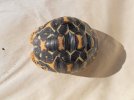- Joined
- Jul 7, 2011
- Messages
- 35
Everyone says that calcium is an imperative part of any tortoise's diet, right? And it should prevent pyramiding (alongside sufficient vitamin D3/UVB and fibre), right?
But if we know (or at least just suspect) that these should create smooth-shelled chelonians indefinitely (depending on the species' place of origin), why aren't ALL our tortoises smooth??
Assuming the not-so-smooth tortoise owners know and understand the exact requirements (that experts/professionals/enthusiast provide), why do some tortoises present pyramidal growth?
What my hypothesis is is that we have something wrong in our understanding of tortoise chemistry. I'm thinking along the lines of the calcium absorption.
From my understanding of Tom's past experiments, moisture has a significant impact on the tortoise's overall shell-shape (I'm pretty much accepting this as gospel haha). But any who...
To be exact on my hypothesis, I believe we provide too much calcium! Knowing that calcium is water-soluble, I'm inferring that when we provide too much calcium in our tortoise's diet, the added moisture and baths will provide enough water to flush out any excess calcium (which I am going to assume causes pyramiding).
I may be wrong, however. (I'm no biochem specialist haha). Where my hypothesis falls is when UVB and Vitamin D3 is introduced into the body. A good owner knows to provide enough light/supplements so that calcium build-up in the system won't hurt...
I'm very curious to find an answer! Anyone have any suggestions or theories or anything??
ALSO! (I'm starting to think out loud aha ) In the wild, tortoises may not find sufficient calcium in their environment...but they're almost always smooth-shelled. They'll undoubtedly get good amounts of UVB/D3, but get varying levels of calcium... Hmm.
Any added information???
Please don't be afraid to hypothesize or provide personal experiences!
But if we know (or at least just suspect) that these should create smooth-shelled chelonians indefinitely (depending on the species' place of origin), why aren't ALL our tortoises smooth??
Assuming the not-so-smooth tortoise owners know and understand the exact requirements (that experts/professionals/enthusiast provide), why do some tortoises present pyramidal growth?
What my hypothesis is is that we have something wrong in our understanding of tortoise chemistry. I'm thinking along the lines of the calcium absorption.
From my understanding of Tom's past experiments, moisture has a significant impact on the tortoise's overall shell-shape (I'm pretty much accepting this as gospel haha). But any who...
To be exact on my hypothesis, I believe we provide too much calcium! Knowing that calcium is water-soluble, I'm inferring that when we provide too much calcium in our tortoise's diet, the added moisture and baths will provide enough water to flush out any excess calcium (which I am going to assume causes pyramiding).
I may be wrong, however. (I'm no biochem specialist haha). Where my hypothesis falls is when UVB and Vitamin D3 is introduced into the body. A good owner knows to provide enough light/supplements so that calcium build-up in the system won't hurt...
I'm very curious to find an answer! Anyone have any suggestions or theories or anything??
ALSO! (I'm starting to think out loud aha ) In the wild, tortoises may not find sufficient calcium in their environment...but they're almost always smooth-shelled. They'll undoubtedly get good amounts of UVB/D3, but get varying levels of calcium... Hmm.
Any added information???
Please don't be afraid to hypothesize or provide personal experiences!
